Monday, November 2nd 2015

AMD Radeon Software Crimson Edition Detailed
In the beginning, there were NVIDIA Detonator and ATI Catalyst. Detonator made way for GeForce Software, but Catalyst pulled through for another decade. These are the brand names GPU makers use to label their drivers, because GPUs are devices that warrant frequent driver updates to keep up with new software and performance improvements. AMD, after consolidating most of its visual computing divisions into the Radeon Technologies Group under technocrat Raja Koduri, made its first major announcement, re-branding AMD Catalyst as Radeon Software. Its first release gets a special name - Radeon Software Crimson Edition 15.11.
AMD's new nomenclature for its drivers involves firmly placing the Radeon brand name, replacing "Catalyst," followed by "software," indicating that these are not just drivers, but a suite of applications designed to give you control over your visual computing experience; with "Crimson Edition" being the major version for the year 2015-16, and 15.11 denoting November 2015, retaining the date-based version numbering scheme. These could come with extensions such as "WHQL" or "Beta." The first Crimson Edition drivers will be WHQL-signed.At the center of Radeon Software Crimson Edition 15.11 is the doing away of Catalyst Control Center (CCC) and Raptr, and in their place, a slick new application built from the ground up, called Radeon Settings. This app no longer relies on .NET, unlike CCC. Its user interface is minimalist, and keeps up with the Windows 10 theme, but its variations could blend with OS X and Linux GUIs.The application is designed for fast startup, and features a ribbon-tab UI design, with a top bar selecting main settings pages, and the bottom one with minor settings and social buttons. With Raptr gone, game-specific optical settings are care of the "Games" tab, in which you can make graphics and hardware overclocking settings specific to a game, besides global settings.The "Video" tab lets you choose between eight presets specific to viewing situations and content. The "Display" tab gives you settings specific to your display (resolution, refresh rates, Virtual SuperResolution, scaling, etc. There's a tab specific to Eyefinity that shows up when there is more than one display. And finally, the "System" tab gives you information on your current hardware and software environment.
The most important settings from the Radeon Settings app are neatly integrated into the context menu of the tray icon.
AMD will release Radeon Software Crimson Edition later this month.
AMD's new nomenclature for its drivers involves firmly placing the Radeon brand name, replacing "Catalyst," followed by "software," indicating that these are not just drivers, but a suite of applications designed to give you control over your visual computing experience; with "Crimson Edition" being the major version for the year 2015-16, and 15.11 denoting November 2015, retaining the date-based version numbering scheme. These could come with extensions such as "WHQL" or "Beta." The first Crimson Edition drivers will be WHQL-signed.At the center of Radeon Software Crimson Edition 15.11 is the doing away of Catalyst Control Center (CCC) and Raptr, and in their place, a slick new application built from the ground up, called Radeon Settings. This app no longer relies on .NET, unlike CCC. Its user interface is minimalist, and keeps up with the Windows 10 theme, but its variations could blend with OS X and Linux GUIs.The application is designed for fast startup, and features a ribbon-tab UI design, with a top bar selecting main settings pages, and the bottom one with minor settings and social buttons. With Raptr gone, game-specific optical settings are care of the "Games" tab, in which you can make graphics and hardware overclocking settings specific to a game, besides global settings.The "Video" tab lets you choose between eight presets specific to viewing situations and content. The "Display" tab gives you settings specific to your display (resolution, refresh rates, Virtual SuperResolution, scaling, etc. There's a tab specific to Eyefinity that shows up when there is more than one display. And finally, the "System" tab gives you information on your current hardware and software environment.
The most important settings from the Radeon Settings app are neatly integrated into the context menu of the tray icon.
AMD will release Radeon Software Crimson Edition later this month.
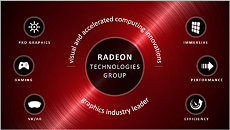
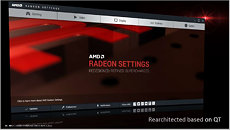
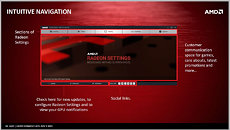
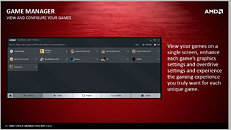
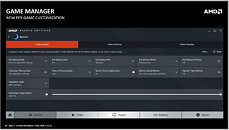
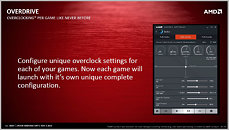
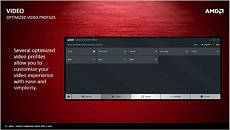
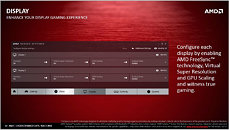
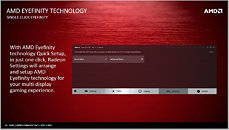
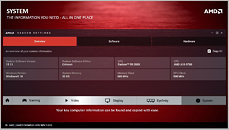
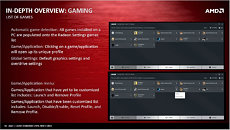
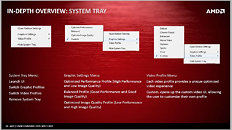
70 Comments on AMD Radeon Software Crimson Edition Detailed
The last reptile that needs culling is Razer Synapse... gosh how I hate that thing... if there was an alternative that sets up the driver and mouse settings... but there is none on windows...
take me forever to remember where things are now.
per game OCing is awesome, underclocking for older games is a fantastic idea.
Still, not a bad design, not bad at all!
We are entering a new era of stability for radeon drivers.
If this is a means to start bringing nice features, like what Nvidia has done with their GeForce experience, then I'd be willing to try that. Just hope AMD doesn't force driver updates via this Radeon software
I'm on NVIDIA now, but I'm certainly looking forward to another Radeon graphic card knowing I'll experience a better settings GUI.